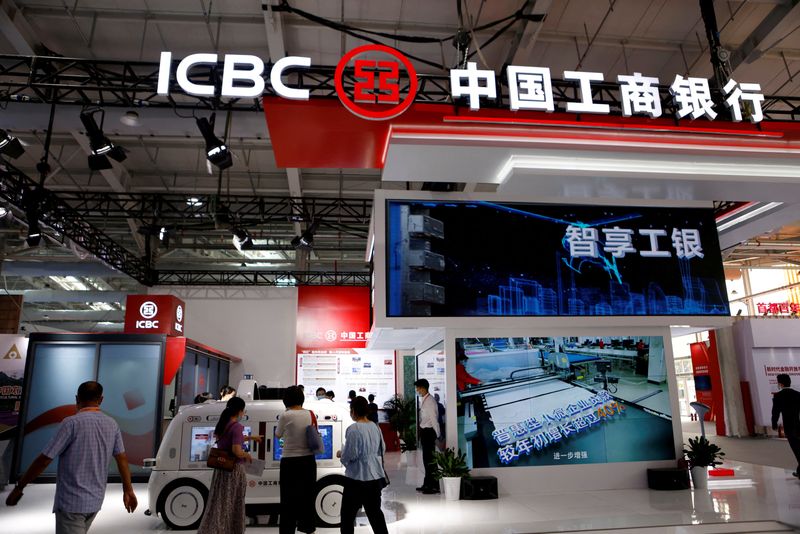
© Reuters. FILE PHOTO: People visit the Industrial and Commercial Bank of China (ICBC) booth at the 2021 China International Fair for Trade in Services (CIFTIS) in Beijing, China September 3, 2021. REUTERS/Florence Lo/File Photo/File Photo
(Corrects typographical error in paragraph 8)
BEIJING (Reuters) – Top tier Chinese banks preparing to respond to Beijing’s call to boost lending to the real economy and debt-laden property sector are set to face a squeeze on their profit margins in the second half, bankers and analysts said.
Five of China’s biggest state-owned banks posted modest gains in profits in the second quarter. Four of the banks, except for Bank of China, however, reported falling net interest margins, a key gauge of bank profitability.
The dour outlook for Chinese banks comes as the world’s second-largest economy narrowly avoided contracting in the second quarter as widespread COVID-19 lockdowns and the slumping property sector badly damaged consumer and business confidence.
With economic momentum cooling, Beijing has unveiled a string of interest rate cuts in the last few months and has been stepping up pressure on lenders with new instructions to grow loans.
Lower asset yields as a result of reduced benchmark interest rates and continuing competition for deposits, a key source of funding for Chinese banks, means interest margins of banks will see greater pressure, analysts said.
Banks have been asked by the Chinese government to support the country’s cash-strapped property sector, which accounts for nearly a quarter of gross domestic product.
“Now they are told to support because the sector is going to (need) help … and I think there is no worse time because interest rates are on the way down and net interest margin has narrowed … the banks have much less leeway,” said Alicia García Herrero, chief economist for Asia Pacific at Natixis.
Narrower net interest margins – how much banks earn in interest from loans compared to what they pay out in interest on deposits – will affect their profitability, leading to lower dividends for shareholders and weakening market confidence.
Four of China’s Big Five banks — China Construction Bank (OTC:CICHF) Corp (CCB), Agricultural Bank of China (OTC:ACGBF) (AgBank), Bank of Communications (BoCom) and Bank of China (BoC), flagged narrowing net interest margin (NIM) when they reported their results late last month.
Aside from Bank of China, all four of the top five banks including Industrial and Commercial Bank of China Ltd (ICBC), the world’s largest commercial lender by assets, saw a drop in their NIM.
For the full year, NIM of BoC is expected to fall to 1.71% from 1.76% at end-June, while that of AgBank should ease to 2.06% from 2.02% and CCB to 2.08% from 2.09%, according to Refinitiv data based on analysts forecast.
“Looking forward, the banking industry will face pressure of narrowing net interest margin,” Liu Jin, chairman of BoC told a post-earnings conference last week.
‘FULFILLING THE RESPONSIBILITY’
Lower NIM will strain profitability, said Nicholas Zhu, a banking analyst at Moody’s (NYSE:MCO). China’s Big Four banks’ profitability — as measured by return on assets — will stabilise just below 1% over the next 12 to 18 months, he said.
The prospect of lower margins and profitability is, however, not expected to dissuade some of the top state-owned banks from heeding the call from authorities to boost lending to support the slowing economy.
“Our rate of return from loans will slightly fall, but we will continue to fulfill the responsibility of a big state-owned bank,” said BoC’s Liu. “(We will) enhance support for the real economy, maintain steady growth in loans, to help stabilise the economy.”
President of CCB Zhang Jinliang said the bank’s loan yield could decline in the second half of this year, but added the bank would continue to follow the government’s directive to lower borrowing costs for smaller enterprises.
And to keep the NIM at “a reasonable level,” the bank will put an emphasis on controlling costs on deposits, Zhang said. (This story refiles to correct typographical error in paragraph 8)
Source: Investing.com




























